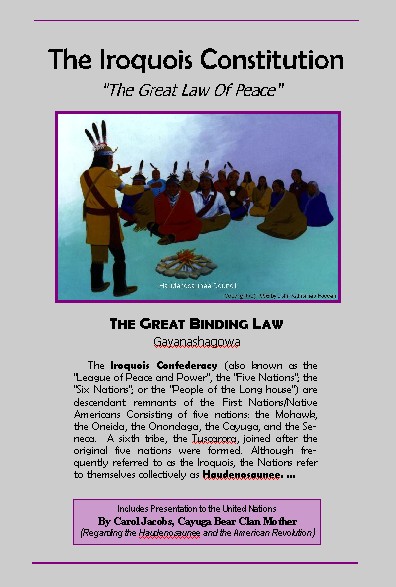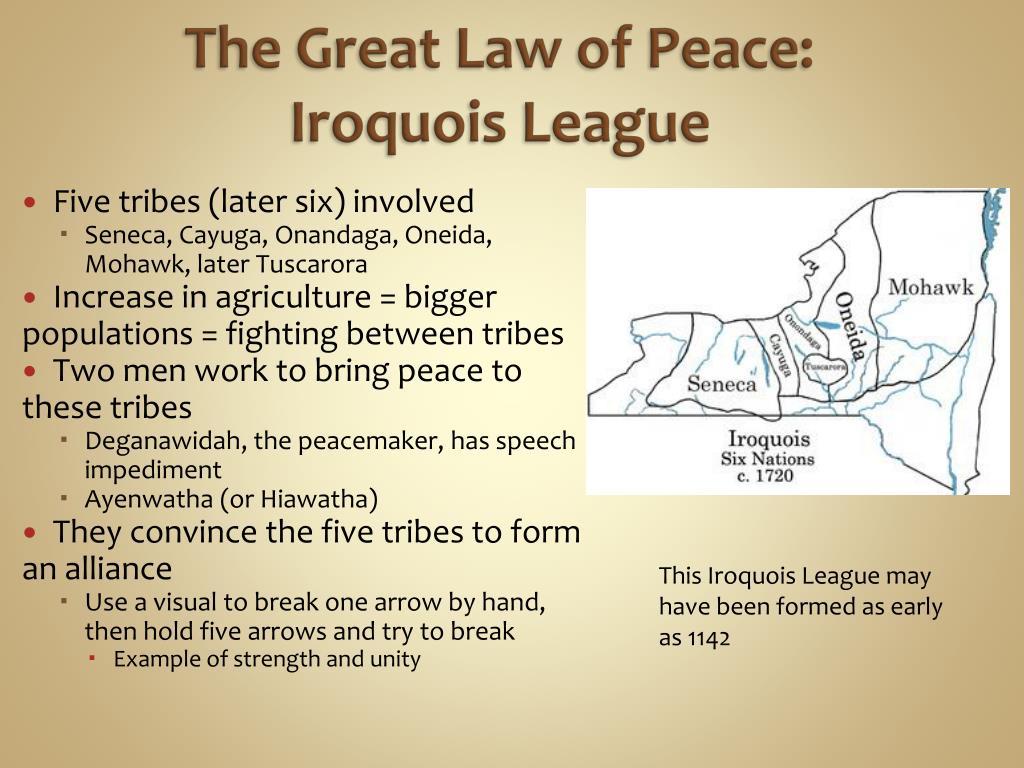
The Enduring Canopy: Unearthing the Principles of the Iroquois Great Law of Peace
By [Your Name/Journalist’s Name]
In a world perpetually grappling with conflict, division, and the relentless pursuit of short-term gains, ancient wisdom often offers the most profound remedies. Buried not in dusty tomes but in centuries of oral tradition and the living practice of a vibrant Indigenous culture, lies a blueprint for peace, governance, and ecological harmony that continues to resonate with startling relevance today: the Great Law of Peace of the Haudenosaunee, also known as the Iroquois Confederacy.

More than just a set of rules, the Kaianere’kó:wa, or Great Law, is a foundational philosophy that transformed five warring nations—the Mohawk, Oneida, Onondaga, Cayuga, and Seneca—into a powerful and enduring league long before European contact. It’s a testament to humanity’s capacity for reconciliation and the construction of a society based on principles far removed from coercion and conquest.
The Genesis of a Grand Vision
The genesis of the Great Law is shrouded in myth and history, attributed to two visionary figures: the Peacemaker (Deganawida) and his disciple, Hiawatha. Legend tells of a time of relentless warfare and chaos among the nations inhabiting what is now upstate New York and parts of Canada. The Peacemaker, carrying a message of peace, power, and righteousness, sought to unite these fragmented peoples under a single, overarching law.
His greatest challenge lay in converting Tadodaho, a fearsome Onondaga chief whose mind was said to be twisted and whose hair was entangled with living snakes, symbolizing his malevolence and the chaos he embodied. Through the patient efforts of the Peacemaker and Hiawatha, Tadodaho was finally persuaded to cast aside his old ways. His snakes were combed from his hair, his mind was straightened, and he became the spiritual keeper of the Great Law, symbolizing the transformation from discord to unity. This powerful narrative underscores the Law’s core belief in the possibility of radical change and reconciliation, even with the most entrenched adversaries.
The Great Law was not merely a cessation of hostilities; it was a sophisticated framework for governance, diplomacy, and societal well-being. It established a Grand Council of 50 male chiefs (Hoyaneh), chosen by the Clan Mothers, who represented the various nations and clans. This bicameral system, with "Elder Brothers" (Mohawk and Seneca) and "Younger Brothers" (Oneida and Cayuga) debating issues before sending them to the Onondaga (the "Firekeepers") for final consensus, ensured thorough deliberation and balanced representation.
Pillars of the Great Law: Principles for a Harmonious Existence
The principles embedded within the Great Law are not abstract ideals but practical guidelines for daily life, governance, and interaction with the natural world.
1. Consensus and Collective Decision-Making:

At the heart of the Great Law is the principle of consensus. Decisions within the Grand Council were not made by simple majority vote but through a painstaking process of discussion, debate, and compromise until a solution agreeable to all was reached. This process, often lengthy, ensured that all voices were heard, all perspectives considered, and that the resulting decision had the full backing of the people. It fostered unity and avoided the tyranny of the majority or the frustration of a disaffected minority. As Haudenosaunee scholar Robert W. Venables notes, "The Haudenosaunee political process was designed to prevent divisions and to promote unity."
2. The Power of the Clan Mothers:
Perhaps one of the most striking and progressive aspects of the Great Law is the pivotal role of women, particularly the Clan Mothers. These elder women were the keepers of the lineage, the cultivators of the land, and the spiritual backbone of the clans. Crucially, they held the power to select the male chiefs and, if a chief failed in his duties or acted against the Law, they had the authority to "de-horn" him, effectively removing him from office. This matriarchal influence ensured that leadership was accountable to the people and reflected the community’s values, long before universal suffrage became a concept in Western democracies.
3. Long-Term Vision: The Seventh Generation Principle:
A cornerstone of Haudenosaunee philosophy, the Seventh Generation Principle dictates that all decisions made today must consider their impact on the next seven generations. This profound ecological and social foresight encourages sustainable practices, responsible resource management, and a deep sense of intergenerational responsibility. It stands in stark contrast to modern political cycles often driven by immediate electoral gains. "In our every deliberation, we must consider the impact of our decisions on the next seven generations," is a maxim that guides the Haudenosaunee to this day, making them inherent environmental stewards.
4. Balance and Harmony:
The Great Law emphasizes balance in all things: between the individual and the community, between humans and nature, between rights and responsibilities. It seeks to create a harmonious existence where peace is not merely the absence of war, but a state of dynamic equilibrium. This balance extends to the internal peace of individuals, promoting self-control and wisdom as prerequisites for effective leadership and community participation.
5. Justice as Restoration and Reconciliation:
Unlike punitive justice systems focused on punishment, the Great Law emphasized restorative justice. When an offense occurred, the focus was on healing the victim, reconciling the parties, and restoring balance to the community. Compensation, apology, and community support were prioritized over retribution. This approach aimed to mend the social fabric rather than simply punish the offender, reflecting the belief that all members of the community had value and could be brought back into harmony.
Symbols of Enduring Peace
The principles of the Great Law are embodied in powerful symbols:
- The Great Tree of Peace (White Pine): Planted by the Peacemaker, this tree symbolizes the Confederacy. Beneath its roots, all weapons of war were buried, signifying the end of conflict. Its roots spread in the four cardinal directions, inviting all nations to join the peace.
- The Eagle: Perched atop the Tree of Peace, the eagle acts as a watchful guardian, warning the Haudenosaunee of any approaching danger, whether physical or spiritual. It represents vigilance and foresight.
- Wampum Belts: These intricate belts, woven from quahog shells, served as living documents, recording treaties, laws, and historical events. The patterns and colors conveyed specific meanings, preserving the oral tradition and ensuring the accuracy of agreements. The Two Row Wampum, for instance, symbolizes the parallel but independent paths of Indigenous peoples and European newcomers, each in their own vessel, respecting each other’s sovereignty.
A Legacy That Echoes Through Time
The influence of the Great Law of Peace extends far beyond the borders of the Haudenosaunee territories. While the extent of its direct influence on the drafting of the U.S. Constitution remains a subject of academic debate, many scholars point to compelling parallels. Concepts such as federalism, checks and balances, the separation of powers, and the idea of popular sovereignty (rooted in the power of the Clan Mothers and the consensus model) resonate strongly with the Haudenosaunee system. Benjamin Franklin, among other Founding Fathers, was known to have studied the Iroquois Confederacy, marveling at its stability and democratic principles.
Despite centuries of colonialism, land dispossession, and attempts at assimilation, the Haudenosaunee have steadfastly preserved the Great Law. It continues to guide their governance, inform their relationship with the environment, and inspire their advocacy for Indigenous rights globally.
In an era defined by geopolitical instability, climate crisis, and social fragmentation, the ancient wisdom of the Great Law of Peace offers a profound beacon. Its emphasis on consensus, long-term thinking, gender equity, restorative justice, and harmonious coexistence with nature presents a compelling alternative to prevailing paradigms. The Haudenosaunee remind us that true peace is not merely the absence of war, but the active cultivation of justice, respect, and balance—a canopy under which all beings can thrive for generations to come. The roots of their Great Tree of Peace continue to spread, inviting all to learn from its enduring shade.


